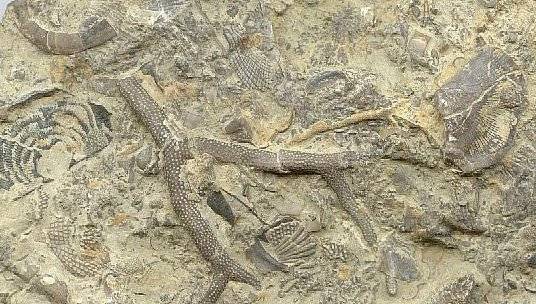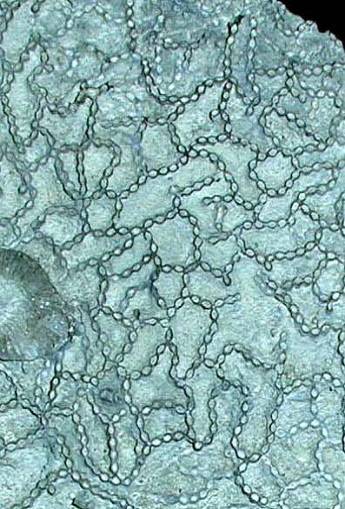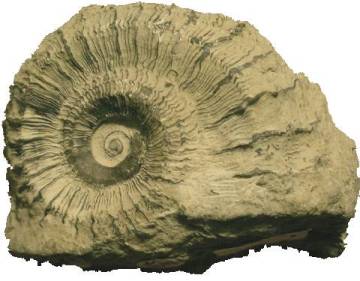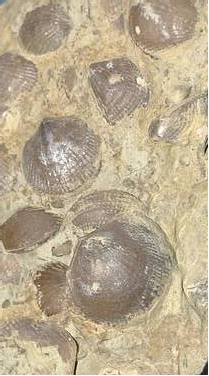Fossils
What are fossils?
Fossils are the remains of ancient animals and plants (or their tracks and traces) that have been preserved in stone. Typically, only the hard parts like bones and shells are all that now remain. The soft parts usually rot away with the passing of time. Only in very rare and very special conditions do we get a glimpse of what the soft parts were once like. We never get to see the colour of the animal or plant when it has been fossilised. Many fossils that we find in the rocks are from animals that no longer can be found alive on Earth, like dinosaurs and trilobites. These animals died out many millions of years ago and long before man ever walked on the Earth.
Below are some typical local Dudley fossils of Silurian age.
Hover the cursor over photograph to enlarge and learn about them.
 Calymene blumenbachii. Known locally as the Dudley Bug, Calymene blumenbachii is a Trilobite. Although now extinct they were closely related to crustaceans such as lobsters and crabs. With segmented bodies, many jointed legs and hard external skeletons, which are preserved as fossils. Calymene, has large, powerful eyes which helped it to detect and catch prey. The earliest trilobites were predators, catching worms and other soft animals. Others fed on tiny pieces of food on the sea bed, or filtered food out of the sea water. Trilobites could also roll up to protect their soft underparts, in the same way that woodlice roll up when threatened.
Calymene blumenbachii. Known locally as the Dudley Bug, Calymene blumenbachii is a Trilobite. Although now extinct they were closely related to crustaceans such as lobsters and crabs. With segmented bodies, many jointed legs and hard external skeletons, which are preserved as fossils. Calymene, has large, powerful eyes which helped it to detect and catch prey. The earliest trilobites were predators, catching worms and other soft animals. Others fed on tiny pieces of food on the sea bed, or filtered food out of the sea water. Trilobites could also roll up to protect their soft underparts, in the same way that woodlice roll up when threatened.  Fenestella reteporata. Bryozoans, or ‘moss-animals’ are colonial animals which are common in shallow seawater. They build colony skeletons of calcium carbonate. Although the individual animals are very tiny, they are quite complex with nervous systems and feeding organs. The colonies can be fan-shaped or branching, or can encrust other organisms such as seaweed.
Fenestella reteporata. Bryozoans, or ‘moss-animals’ are colonial animals which are common in shallow seawater. They build colony skeletons of calcium carbonate. Although the individual animals are very tiny, they are quite complex with nervous systems and feeding organs. The colonies can be fan-shaped or branching, or can encrust other organisms such as seaweed. Halysites catenularis. Also known as ‘chain coral’. Corals are simple animals closely related to sea anemones and jellyfish. Modern corals belong to a group called the Scleractinians, which first appeared 240 million years ago. In earlier rocks, including the Wenlock limestone, two different types of corals are found: Tabulate corals and Rugose corals. Corals live either singly or in colonies. Many have solid calcium carbonate skeletons which can develop into very large, complex structures.
Halysites catenularis. Also known as ‘chain coral’. Corals are simple animals closely related to sea anemones and jellyfish. Modern corals belong to a group called the Scleractinians, which first appeared 240 million years ago. In earlier rocks, including the Wenlock limestone, two different types of corals are found: Tabulate corals and Rugose corals. Corals live either singly or in colonies. Many have solid calcium carbonate skeletons which can develop into very large, complex structures. Poleumita discors. Gastropods are a group of molluscs which includes snails and slugs. They are found in many different environments – on land, in rivers and lakes as well as in the sea. Wenlock gastropods lived in the sea, as it wasn’t until the Jurassic that snails first appeared on land. They can be herbivores, scavengers or carnivores. Many gastropods have coiled calcium carbonate shells – although some, such as slugs, have no shell at all. Shell-less gastropods do not fossilise well, but those with shells are very common in rocks of many different ages.
Poleumita discors. Gastropods are a group of molluscs which includes snails and slugs. They are found in many different environments – on land, in rivers and lakes as well as in the sea. Wenlock gastropods lived in the sea, as it wasn’t until the Jurassic that snails first appeared on land. They can be herbivores, scavengers or carnivores. Many gastropods have coiled calcium carbonate shells – although some, such as slugs, have no shell at all. Shell-less gastropods do not fossilise well, but those with shells are very common in rocks of many different ages. Gissocrinus. Crinoids are often known as sea lilies, but they are not plants. They are most closely related to starfish and sea urchins, and belong to a group of animals called echinoderms. Crinoids live on or near to the sea floor. Many fossil crinoids have a long cylindrical ‘stem’ which fixed them to the sea bed, but far enough above it to lift them above the feeding level of other filter feeders. Modern crinoids are often stemless and can move around, using their ‘arms’ to help them to crawl over the seafloor.
Gissocrinus. Crinoids are often known as sea lilies, but they are not plants. They are most closely related to starfish and sea urchins, and belong to a group of animals called echinoderms. Crinoids live on or near to the sea floor. Many fossil crinoids have a long cylindrical ‘stem’ which fixed them to the sea bed, but far enough above it to lift them above the feeding level of other filter feeders. Modern crinoids are often stemless and can move around, using their ‘arms’ to help them to crawl over the seafloor. Atripa reticularis. Brachiopods are rare today, but were extremely common in the sea in the geological past. They have two shells made of calcite, held together by muscles, which they open when feeding and close for protection. Although they can look similar to bivalves, they are unrelated. Fossil brachiopods have many different shell shapes, which reflect the very different sea bed environments in which they lived.
Atripa reticularis. Brachiopods are rare today, but were extremely common in the sea in the geological past. They have two shells made of calcite, held together by muscles, which they open when feeding and close for protection. Although they can look similar to bivalves, they are unrelated. Fossil brachiopods have many different shell shapes, which reflect the very different sea bed environments in which they lived.
Download Dudley Museum’s guide about fossils. (PDF 37KB)
Explore the Wenlock Reef – Sedgwick Museum interactive site.
